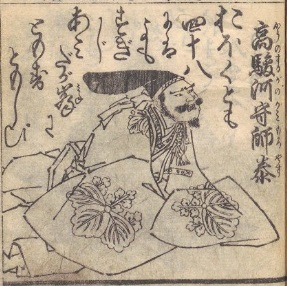Kō No Moroyasu on:
[Wikipedia]
[Google]
[Amazon]
 Iwanami Nihonshi Jiten was one of the leading generals of
Iwanami Nihonshi Jiten was one of the leading generals of
 Iwanami Nihonshi Jiten was one of the leading generals of
Iwanami Nihonshi Jiten was one of the leading generals of Shōgun
, officially , was the title of the military rulers of Japan during most of the period spanning from 1185 to 1868. Nominally appointed by the Emperor, shoguns were usually the de facto rulers of the country, except during parts of the Kamak ...
Ashikaga Takauji
also known as Minamoto no Takauji was the founder and first ''shōgun'' of the Ashikaga shogunate."Ashikaga Takauji" in ''Encyclopædia Britannica, The New Encyclopædia Britannica''. Chicago: Encyclopædia Britannica Inc., 15th edn., 1992, Vol. ...
during the Nanboku-chō period
The , also known as the Northern and Southern Courts period, was a period in Japanese history between 1336-1392 CE, during the formative years of the Ashikaga shogunate, Muromachi (Ashikaga) shogunate. Ideologically, the two courts fought for 50 ...
, along with his brother Moronao and his cousin Morofuyu.
Life
In 1335 he was sent west fromKamakura
, officially , is a city of Kanagawa Prefecture in Japan. It is located in the Kanto region on the island of Honshu. The city has an estimated population of 172,929 (1 September 2020) and a population density of 4,359 people per km2 over the tota ...
, the capital, at the head of a large army. The goal was to secure the shōgun's control over the region, and prepare for an attack to the west, expanding the Shōgun's power. However, the Imperial Court sent its army, bolstered by warriors from across the country, against the shogunate and against Moroyasu and Moronao in particular. This army, led by Nitta Yoshisada
also known as Minamoto no Yoshisada was a samurai lord of the Nanboku-chō period Japan. He was the head of the Nitta clan in the early fourteenth century, and supported the Southern Court of Emperor Go-Daigo in the Nanboku-chō period. He famo ...
, met Moroyasu's force on 10 December, and they fought again ten days later. After a number of skirmishes, Moroyasu's army, despite being reinforced by men under Ashikaga Tadayoshi
"Ashikaga Tadayoshi" in ''Encyclopædia Britannica, The New Encyclopædia Britannica''. Chicago: Encyclopædia Britannica Inc., 15th edn., 1992, Vol. 1, p. 624. was a general of the Nanboku-chō period, Northern and Southern Courts period (1337� ...
, was defeated, and withdrew into the Hakone Mountains. Here, at Sanoyama and Mishima, another set of skirmishes took place, eventually resulting in the destruction of Nitta's Imperial force when the shōgun arrived with further reinforcements.
The Taiheiki
The (Chronicle of Great Peace) is a medieval Japanese historical epic (see '' gunki monogatari'') written in the late 14th century and covers the period from 1319 to 1367. It deals primarily with the Nanboku-chō, the period of war between the ...
, an epic dedicated to the events of this period, describes the Kō brothers as avid villains. This description is likely accurate. Both brothers during their careers were extremely useful to Takauji, but because of their violent character, they also made him many powerful enemies. Most importantly, Moronao was bitterly opposed to Takauji's younger brother Tadayoshi and his policies. This enmity would be the main trigger of the Kannō Disturbance
The , also called ''Kannō no juran'', was a civil war which developed from antagonisms between ''shōgun'' Ashikaga Takauji and his brother, Ashikaga Tadayoshi, thus dividing and weakening the early Ashikaga shogunate.Nussbaum, Louis-Frédéric ...
, an extremely divisive and damaging civil war between Takauji and Tadayoshi with very serious repercussions for the whole country.
Although Takauji ultimately won, he was initially defeated in March 1351 by Tadayoshi and a truce was agreed upon with the help of Zen
Zen (; from Chinese: ''Chán''; in Korean: ''Sŏn'', and Vietnamese: ''Thiền'') is a Mahayana Buddhist tradition that developed in China during the Tang dynasty by blending Indian Mahayana Buddhism, particularly Yogacara and Madhyamaka phil ...
master Musō Soseki, who was close to both sides. One of the conditions posed by Tadayoshi was that the Kō brothers would retire from politics forever and become monks, which they did. Moronao became a Zen monk and Moroyasu a member of the Nembutsu
file:玉里華山寺 (21)南無阿彌陀佛古碑.jpg, 250px, Chinese Nianfo carving
The Nianfo ( zh, t=wikt:念佛, 念佛, p=niànfó, alternatively in Japanese language, Japanese ; ; or ) is a Buddhist practice central to East Asian Buddhism. ...
fraternity. They later left Hyōgo for Kyoto accompanied by Takauji, but they would never arrive. The Kō were captured and then executed with many dozens of their family at the Muko River
The is a river in the south-eastern part of Hyōgo Prefecture. This river was selected as the second most important river in the region by the prefecture governor. Its total length is 66 kilometers, and the drainage area is 496 square kilometers. ...
by forces led by Uesugi Akiyoshi on 25 March, 1351 ('' Kannō 2, 27th day of the 2nd month'') in revenge for their killing of Akiyoshi's father Shigeyoshi. Takauji, powerless, had to deliver them to Akiyoshi.
See also
* Siege of Kanegasaki (1337)References
References
* Iwanami Nihonshi Jiten (岩波日本史辞典), CD-Rom Version. Iwanami Shoten, 1999–2001. * Sansom, George (1961). "A History of Japan: 1334-1615." Stanford, California: Stanford University Press. 1351 deaths Samurai Year of birth unknown {{samurai-stub